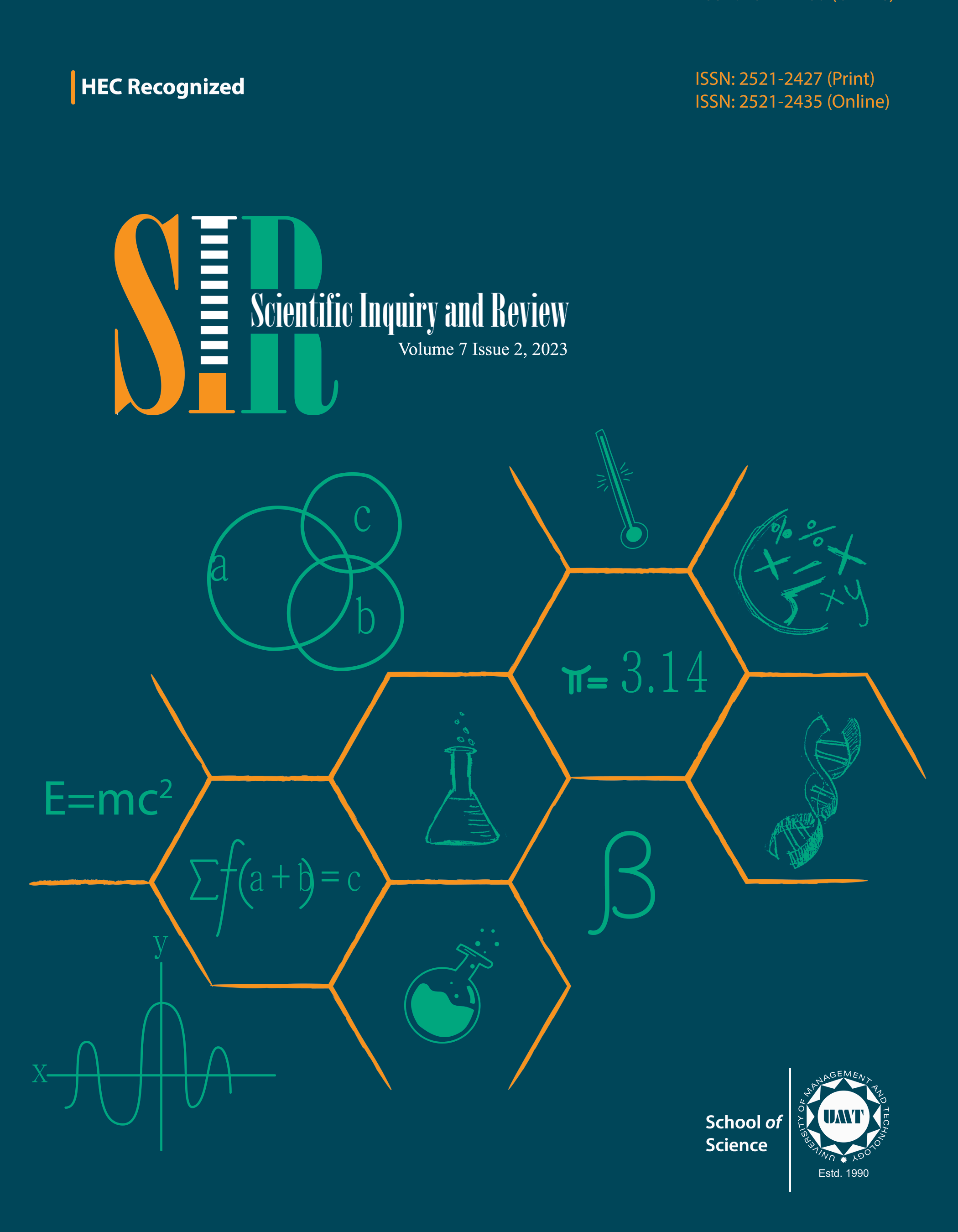Isolation and Identification of Lawsonia Content from the Leaves of Henna (Lawsonia inermis)
Abstract
 Abstract Views: 36
Abstract Views: 36
Lawsone is an orange red dye mainly isolated from Lawsonia inermis plant leaves. L. inermis is commonly known as henna plant, Egyptian privet, or mignonette tree. In Pakistan, henna is known as mehndi. Paste from thick henna leaves has been used to dye hairs, fingernails, palms of hands, and eyebrows for more than 5000 years. The characteristic colour of henna is because of the natural dye lawsone present in it. In this study, lawsone was extracted from four samples of henna leaves collected from various parts of Pakistan. Moreover, the impact of the environment on the leaves was examined. Lawsone was extracted using diethyl ether, so that the maximum amount of lawsone could be isolated from the leaves. The maximum and minimum amount of lawsone isolated during this work was 1.01% and 0.745% of dry weight, respectively. Afterwards, IR and HPLC were used to identify the isolated reddish-brown substance known as lawsone which is useful in textile, cosmetics, and pharmaceutical sectors.
Downloads
References
Adam AEA, Doctoral dissertation, University of Gezira 2015. http://repo.uofg.edu.sd/handle/123456789/1377
Talab TA, Alfuraiji N, Al-Snafi AE. The analgesic and anti-inflammatory effect of lawsone isolated from lawsonia inermis. Pharm Sci. 2022;1(35),77–84. https://doi.org/10.15587/2519-4852.2022.253555
Younas A, Kiran S, Abrar S, Javed S, Gulzar T. Ultrasonic-assisted extraction and characterization of natural colorants from plants and evaluation of their therapeutic properties and cytotoxicity. Pol J Environ Stud. 2022;31(6),5945-5954. https://doi.org/10.15244/pjoes/151862
Sankar J, Kini M, Mhaskar S, Sangle P. Estimation of lawsone release from Lawsonia inermis Leaf Powder. Trend Agric Sci. 2022;1(1),28-34. https://doi.org/10.17311/tas.2022.28.34
Dixit K, Mohapatra D, Senapat PC, Panda R, Sahu AN. Formulation development and evaluation of Lawsonia inermis extract loaded hydrogel for wound dressing application. Indian J. Pharm. Sci. 2022;84(4),848-862. http://doi.org/10.36468/pharmaceutical-sciences.980
Bakkali AT, Jaziri M, Foriers A, Heyden YV, Vanhaelen M, Homes J. Lawsone accumulation in normal and transformed cultures of henna, Lawsonia inermis. Plant Cell Tissue Organ Cult. 1997;51,83-87. https://doi.org/10.1023/A:1005926228301
Rostowski H, Nowak MJ, Lapinski L, Adamowicz L. Molecular structure and infrared spectra of 2-hydroxy-1,4- naphthoquinone; Experimental matrix isolation and theoretical Hartree–Fock and post Hartree–Fock study. Spectrochim Acta A Mol Biomol Spectrosc. 1998; 54(8) 1091-1103. https://doi.org/10.1016/S1386-1425(98)00032-8
Umadevi R, Gursharanpreet KB, Mariam-Aisha F. Characterisation of henna as a determinant for organic fabric integrity. J Manag Sci. 2016;14(2),45-55.
Jordao AK, Vargas MD, Pinto AC, da Silva FDC, Ferreira VF. Lawsone in organic synthesis. RSC Adv. 2015;5,67909-67943. https://doi.org/10.1039/C5RA12785H
Hijji YM, Barare B, Zhang Y. Lawsone (2-hydroxy-1,4-naphthoquinone) as a sensitive cyanide and acetate sensor. Sens Actuators B Chem. 2012;169(5),106-112. https://doi.org/10.1016/j.snb.2012.03.067
Ostovari A, Hoseinieh SM, Peikari M, Shadizadeh SR, Hashemi SJ. Corrosion inhibition of mild steel in 1 M HCl solution by henna extract: A comparative study of the inhibition by henna and its constituents (Lawsone, Gallic acid, α-D-Glucose and Tannic acid). Corros Sci. 2009;51(9),1935-1949. https://doi.org/10.1016/j.corsci.2009.05.024
Dweck C. Natural ingredients for colouring and styling. Int. J. Cosmet. Sci. 2002;24(5),287-302. https://doi.org/10.1046/j.1467-2494.2002.00148.x
Petkewich, R. Henna dye derived from green leaves is used to decorate the body with intricate designs. J Am Chem Soc. 2006;84,15-20. https://doi.org/10.1021/cen-v084n006.p028
Kapadia GJ, Rao GS, Sridhar R, Ichiishi E, Takasaki M, Suzuki N, Tokuda H. Chemoprevention of Skin Cancer: Effect of Lawsonia inermis L. (Henna) Leaf Powder and its Pigment Artifact, Lawsone in the Epstein- Barr Virus Early Antigen Activation Assay and in Two-Stage Mouse Skin Carcinogenesis Models. Anticancer Agents Med Chem. 2013;13(10),1500-1507. DOI: 10.2174/18715206113139990096
Rahmoun NM, Boucherit-Otmani Z, Boucherit K, Benabdallah M, Villemin D, Choukchou-Braham N. Antibacterial and antifungal activity of lawsone and novel naphthoquinone derivatives. Med Mal Infect. 2012;42(6),270-275. https://doi.org/10.1016/j.medmal.2012.05.002
Alem FZ, Gita SA, Cougnaud L, Affnar C, Nounah I, Youssef B, Oliveira AL, Charrouf Z, Rhourri-Frih B. Lawsone quantification in Lawsonia inermis L. by HPLC-MS: How does the temperature and pluviometry affect lawsone concentration Ind Crops Prod. 2020;158(15),112960. https://doi.org/10.1016/j.indcrop.2020.112960
Bechtold T, Mussak R. Handbook of natural colorants (2009); 151. https://doi.org/10.1002/9780470744970.ch10
Karawya MS, Wahhab SMA, Zaki AY. A study of the lawsone content in henna. Lloydia. 1969;32,76-78.
Barani M, Mirzaei M, Torkzadeh-Mahani M, Nematollahi MH. Lawsone-loaded Niosome and its antitumor activity in MCF-7 breast cancer cell line: a Nano-herbal treatment for cancer. J Pharm Sci. 2018;26,11-17. https://doi.org/10.1007/s40199-018-0207-3
Saeed G, Sayeed SA, Ashraf S, Naz S, Siddiqi R, Ali R, Mesaik MA. A new method for the isolation and purification of Lawsone from Lawsonia Inermis and its ROS inhibitory activity. Pak J Bot. 2013;45(4),1431-1436.
Copyright (c) 2023 Muhammad Aslam

This work is licensed under a Creative Commons Attribution 4.0 International License.






